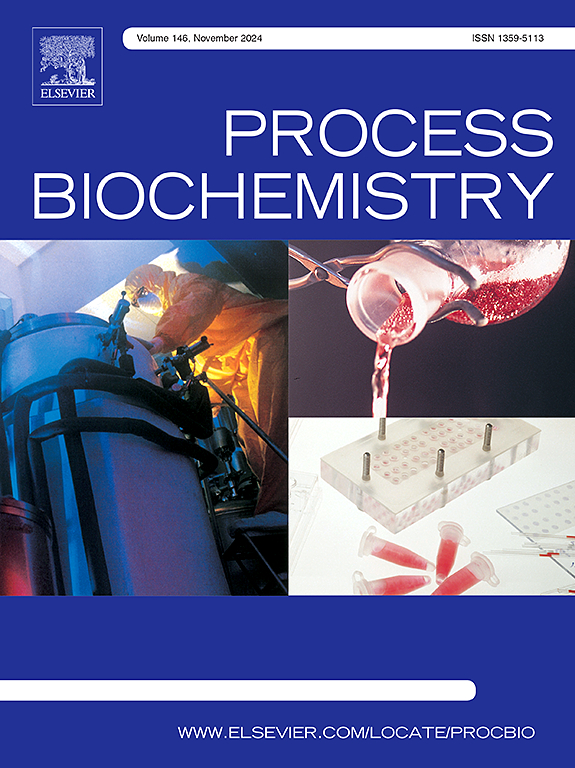Polycaprolactone nanoparticles as a delivery vehicle for styrax liquidus: Therapeutic effects on ulcer and gastric cancer cells
IF 4
3区 生物学
Q2 BIOCHEMISTRY & MOLECULAR BIOLOGY
引用次数: 0
Abstract
Styrax liquidus (SL), a balsam from Liquidambar orientalis Mill., possesses high antioxidant, anti-inflammatory, anti-ulcer, and anti-cancer properties but is limited in food and medicine applications due to the immiscibility, high molecular size, and unable to pass the lipid membranes of the cells. Nano-delivery systems enhance bioavailability, stability, and controlled release of bioactive compounds. In this study, SL-loaded poly(ε-caprolactone) (PCL+SL) nanoparticles were manufactured by nanoprecipitation (NP) and flash nanoprecipitation (FNP) methods. Characterizations included size, PDI, zeta potential, morphology, encapsulation efficiency, and in vitro digestion release studies. SL concentration influenced nanoparticle properties, with FNP yielding efficient and size-controlled particles more readily. Spherical-smooth nanoparticles were produced within size ranges of 220–510 nm for NP and 171–383 nm for FNP, with narrow size distribution PDI (0.2 %). High encapsulation efficiencies and sustained gastric release (69–75 %) with low oral release (1.59–2.88 %) were observed. Optimal formulations showed a gastroprotective effect with high urease inhibition rates in range of 55.80 % - 54.69 % at 0.2 mg/mL concentration. An increased cytotoxicity effect of SL (IC50 of 15.8 µg/mL, 81 % p < 0.0001) against AGS human gastric adenocarcinoma cells, followed by PCL+SL nanoparticles which have potential as “a delivery vehicle” in cancer treatment.
聚己内酯纳米颗粒作为液体styrus的递送载体:对溃疡和胃癌细胞的治疗作用
丁香香脂(SL),产自丁香香脂。具有高抗氧化、抗炎、抗溃疡和抗癌的特性,但由于不混溶性、大分子大小和不能通过细胞脂质膜,在食品和医药方面的应用受到限制。纳米递送系统提高了生物活性化合物的生物利用度、稳定性和可控释放。本研究采用纳米沉淀法(NP)和闪蒸法(FNP)制备了负载SL的聚ε-己内酯(PCL+SL)纳米粒子。表征包括大小、PDI、zeta电位、形态、包封效率和体外消化释放研究。SL浓度影响纳米颗粒的性质,FNP更容易产生高效和尺寸可控的颗粒。制备的球形光滑纳米颗粒的粒径范围为:NP为220 ~ 510 nm, FNP为171 ~ 383 nm,粒径分布PDI较窄(0.2 %)。包封效率高,胃持续释放(69 ~ 75 %),口服释放(1.59 ~ 2.88 %)低。最佳配方在0.2 mg/mL浓度下具有良好的胃保护作用,脲酶抑制率为55.80 % ~ 54.69 %。SL对AGS人胃腺癌细胞的细胞毒性作用增强(IC50为15.8 µg/mL, 81 % p <; 0.0001),其次是PCL+SL纳米颗粒,具有作为癌症治疗“递送载体”的潜力。
本文章由计算机程序翻译,如有差异,请以英文原文为准。
求助全文
约1分钟内获得全文
求助全文
来源期刊

Process Biochemistry
生物-工程:化工
CiteScore
8.30
自引率
4.50%
发文量
374
审稿时长
53 days
期刊介绍:
Process Biochemistry is an application-orientated research journal devoted to reporting advances with originality and novelty, in the science and technology of the processes involving bioactive molecules and living organisms. These processes concern the production of useful metabolites or materials, or the removal of toxic compounds using tools and methods of current biology and engineering. Its main areas of interest include novel bioprocesses and enabling technologies (such as nanobiotechnology, tissue engineering, directed evolution, metabolic engineering, systems biology, and synthetic biology) applicable in food (nutraceutical), healthcare (medical, pharmaceutical, cosmetic), energy (biofuels), environmental, and biorefinery industries and their underlying biological and engineering principles.
 求助内容:
求助内容: 应助结果提醒方式:
应助结果提醒方式:


